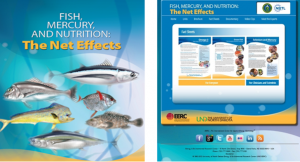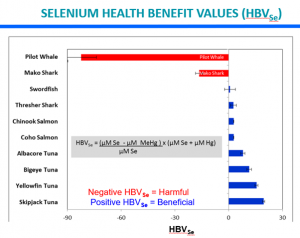Fish should be an important part of our diets. Professor Nick Ralston at the University of North Dakota has drawn our attention to the webpages entitled Fish, Mercury, and Nutrition: The Net Effects. The URL is http://net-effects.und.edu/factsheets.aspx

On these webpages, Professor Ralston and his colleagues explain why the benefits of regularly eating fish, especially ocean fish, are often overlooked. Too many of us have cut back on our fish consumption because we have been worried about exposure to toxic mercury.
However, we have been receiving insufficient information about the relative benefits and risks of eating ocean fish. In fact, our avoiding fish meals may be having negative health consequences in some cases.
- Eating fish is important for pregnant women and babies.
- All of us will benefit from eating fish regularly.
- Eating fish is good for our hearts and our brains.
Nutritional Benefits of Eating Fish Regularly
To a very real extent, we are what we eat. And fish, especially ocean fish, offer a comprehensive nutritional package.
- Fish is a good source of lean protein.
- Fish is the best source of the essential fatty acids that protect against heart disease and promote good brain function and are important for the neurological development of the fetus and the young child.
- Fish is an excellent source of vitamin A (eyes and skin), vitamin D (strong bones), and vitamins C and E (healthy immune system).
- Fish provides minerals like iron, iodine, selenium, and zinc.
Selenium in Most Ocean Fish Protects Against Methylmercury
Most ocean fish contain greater molar amounts of selenium than they contain molar amounts of mercury. Thus, an abundance of selenium in most fish protects us against the methylmercury that is found in fish.
So far, so good. We can eat most fish to get the nutritional benefits. However, bear in mind that the selenium from the fish that we could have used will be bound to mercury and unavailable; we may need additional selenium despite having eaten fish.
The US Food and Drug Administration publishes lists of types of fish that are good choices to eat and types of fish that should be avoided. The URL is https://www.fda.gov/media/102331/download.

Professor Ralston’s Selenium Health Benefit Value Formula and Tables
To assess how much selenium and mercury there is in various types of ocean fish, Professor Ralston has developed the Selenium Health Benefit Value (HBV) formula to calculate the relative risks and benefits of eating ocean fish [Ralston 2016; Ralston 2019].
Ocean fish that contain selenium in molar excess of methylmercury will alleviate the risk of the exposure to the methylmercury in the fish and may to an extent reduce the disruption of beneficial selenoprotein activity in the body and especially in the brain.
Fish in which there is a molar excess of methylmercury over selenium – pilot whale and certain types of sharks – should be avoided.
But eating only fish with a positive Selenium Health Benefit Value does not mean we are free and clear. Please read on to learn about the irony involved in selenium’s protecting us against mercury toxicity.
The Selenium Sequestration Hypothesis
The irony is that the protective binding of selenium with mercury depletes our stores of selenium for the synthesis of much needed selenoproteins. Accordingly, we lose the health benefits of the selenoproteins, e.g. the antioxidative protection against oxidative damage in the brain. That is the price that we pay for selenium’s protection against methylmercury.
In other words, we can eat most types of fish to get the good nutrition that fish provides, but we may need a selenium supplement anyway because the selenium that we would otherwise get from fish is not available to us. Too much of the selenium is bound with the mercury in fish.
Professor Ralston refers to this phenomenon as the selenium sequestration hypothesis. His reasoning is that the neurotoxicity that is commonly associated with mercury is actually the damage that is caused by mercury’s disruption of selenium biochemistry [Ralston 2018 “Mercury’s neurotoxicity …”].
Mercury’s primary targets in our cells are the thioredoxin reductase selenoproteins and the glutathione peroxidase selenoproteins. Mercury binds to the selenocysteine in these selenoproteins and irreversibly inhibits their functions [Ralston 2018 “Mercury’s neurotoxicity …”].
Mercury inhibits the protective antioxidant activity of the thioredoxin reductase and the glutathione peroxidase selenoproteins. Increased oxidative damage caused by reactive oxygen species results.
- Mercury’s binding with selenium depletes the selenium stores needed for the generation of replacement selenoproteins.
- Mercury inhibits the activity of the selenoproteins in the brain that prevent and reverse oxidative damage.
Fish and Selenium for Pregnant and Lactating Women
Please note that eating fish is especially important for pregnant women and for infants.
For example, in a 2018 Cochrane Database review of 70 randomized controlled trials enrolling 19,927 women at various levels of risk of poor pregnancy outcomes, researchers found that the incidence of preterm births (birth < 37 weeks) and the incidence of early preterm births (birth < 34 weeks) were both lower in women who had received omega‐3 fatty acid in their food or supplements compared with no omega‐3 in food or supplements. The researchers also found a reduced risk of low birth-weight babies for mothers who had ingested omega-3 fatty acids in their food and/or supplements [Middleton 2018].
The authors of the Cochrane Database review concluded that omega‐3 fatty acid supplementation during pregnancy is an effective strategy for reducing the incidence of preterm birth. We still need more analysis of clinical trial data relating the efficacy of omega-3 fatty acid supplementation of pregnant and breastfeeding women to the growth and neurological development of their children.
Highlights from Professor Ralston’s Selenium and Mercury Research
- The chemical binding of methylmercury to selenium and the resultant sequestration of selenium by mercury leads to an irreversible inhibition of the activity of the thioredoxin reductase and glutathione peroxidase seleno-enzymes, which are especially important for the prevention and reversal of oxidative damage in the brain. The inhibition of the seleno-enzyme activity is primarily responsible for the characteristic effects of mercury toxicity [Ralston 2018].
- Eating fish regularly is important to good human nutrition: lean protein, essential fatty acids, vitamins and minerals.
- Many more ocean fish are safe to eat than we previously imagined.
- Professor Ralston’s Selenium Healthy Benefit Values for ocean fish provide biochemically based information that supports the FDA/EPA advice for pregnant and breast-feeding women regarding which seafood that should be limited versus the seafood that are beneficial to consume.
- Maternal consumption of seafood has been shown to benefit the child’s neurological development.
- The relationship of selenium and mercury in freshwater fish can be highly variable from region to region. Professor Ralston says that further evaluation of freshwater fish is needed to identify locations where fish with negative selenium health benefit values are caught and eaten [Ralston 2016].
Sources
Ralston NV & Raymond LJ. (2010). Dietary selenium’s protective effects against methylmercury toxicity. Toxicology; 278: 112-23.
Ralston NV, Ralston CR & Raymond LJ. (2016). Selenium Health Benefit Values: Updated criteria for mercury risk assessments. Biol Trace Elem Res.; 171: 262–269.
Ralston NV & Raymond LJ. (2018). Mercury’s neurotoxicity is characterized by its disruption of selenium biochemistry. Biochim Biophys Acta Gen Subj; 1862(11): 2405-16.
Ralston NV. (2018). Effects of soft electrophiles on selenium physiology. Free Radic Biol Med; 127: 134-144.
Ralston NV, Kaneko JJ, & Raymond LJ. (2019). Selenium health benefit values provide a reliable index of seafood benefits vs risks. J Trace Elem Med Biol; 55: 50-57.
The information presented in this review article is not intended as medical advice and should not be used as such.
16 April 2020
